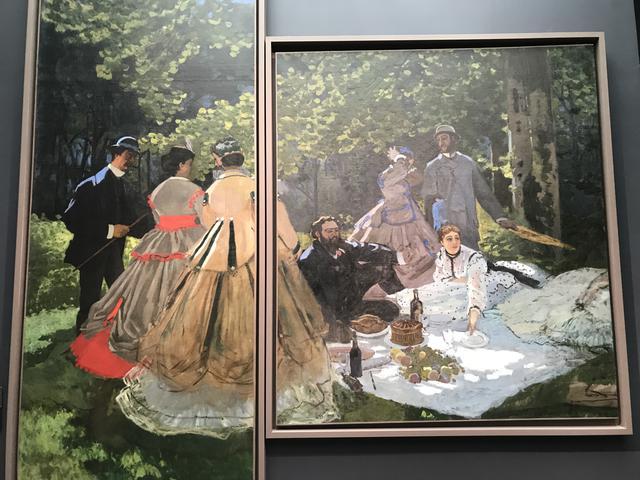Lunch on the grass

"Lunch on the Grass" is a famous painting by Claude Monet that was started in 1865 but never completed. The painting, originally measuring 4x6 meters, was done in oil on canvas and was intended as a tribute to Edouard Manet's painting of the same name. However, as Monet worked on the piece, it also became a subtle criticism of Manet's work. The painting was eventually abandoned in 1866 when Monet left it with his landlord, who rolled it up and stored it in the basement. It wasn't until 1884 that Monet was able to retrieve the canvas, which had become moldy over time. To salvage the work, Monet had to cut it into three pieces, with two fragments now housed in the D'Orsay Museum and the third fragment still missing.
Despite never being completed, "Lunch on the Grass" showcases Monet's talent for capturing the essence of daily life in a realistic manner. The painting was inspired by the Fontainebleau forest, where Monet spent time observing nature and the people around him. However, due to unfavorable weather conditions and a leg injury, Monet was forced to abandon the project in 1866. The decision to leave the painting unfinished was also influenced by Monet's mounting debts at the time.
Monet's approach to "Lunch on the Grass" was conservative, aiming to create a piece that viewers could easily relate to without challenging the societal norms of the era. The painting offers a glimpse into the leisurely activities of the time, with figures lounging in a natural setting. Monet's use of light and color in the painting reflects his mastery of impressionist techniques, capturing the play of sunlight on the grass and the subtle nuances of the human form.
Today, "Lunch on the Grass" remains a significant work in Monet's oeuvre, showcasing his ability to blend traditional subject matter with innovative artistic techniques. The painting serves as a window into the artist's creative process and his dedication to capturing the beauty of everyday life. Visitors to the D'Orsay Museum can experience the fragments of this iconic work firsthand, marveling at Monet's skill in bringing a moment of tranquility and contemplation to life on canvas.
© ChatGPT 3.5
Although it may seem difficult to believe due to all the controversy and criticism that existed with Manet's work, Monet had actually really liked the painting of Eduard Manet whom he admired. The two pieces that still prevail today are in the Orsay Museum, where everyone can appreciate what Monet wanted to do. Although today it is possible to see what the third piece looked like thanks to the original sketches, since the humidity destroyed the third piece.
It is important to note that there is a difference between the sketch and the canvas, a young man sitting on a tablecloth was replaced by a bearded waiter who looks like Gustave Coubert, an acquaintance of Monet.
Monet wanted to work outdoors, but the canvas was too large, so he was forced to work in a workshop. Which is why it also follows the academic rules that were established at that time.
A painting with the large size that it was intended to have and in which the characters were ordinary people living their daily lives, was not something common for that time. And it is here where we can see the influence that realism has on the painter, especially that of Courbet of whom Monet was a great admirer.